
Trending Today
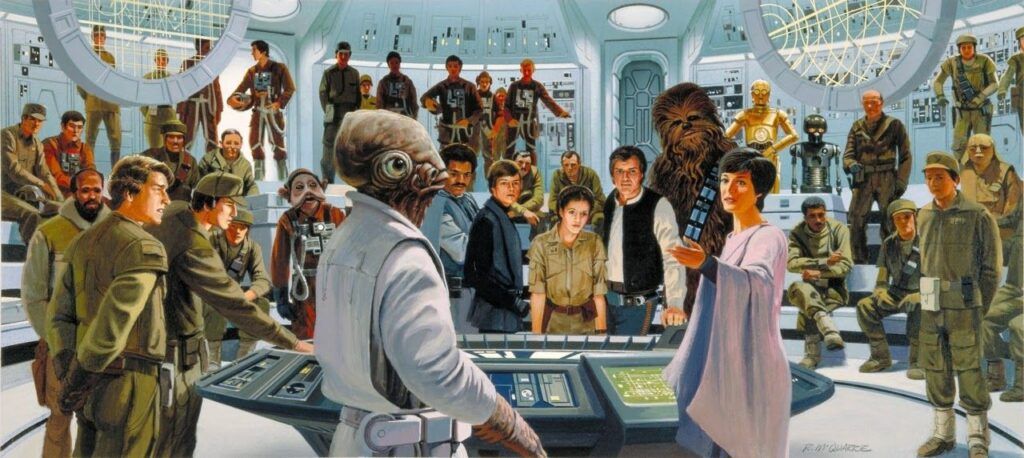
A long time ago, on a blog far, far away, I wrote an article about the basics of competitive list building. It was nearly two years ago, which is quite a long time in the Legion meta.
It’s time for an update. This article will revisit list building considerations for a competitive environment in Star Wars: Legion.
We also covered this topic in detail on our most recent episode of Notorious Scoundrels, which you should check out.
Some important caveats:
1. This will be targeted towards designing a list for a long-form tournament (6 or more rounds), though the guidance should be useful at all levels of play. While certain experimental lists (ahem, “jank”) can succeed in smaller formats, winning six or more games in a row is going to pit you against a variety of lists and opponents and you need a list that is going to be able to handle all of them consistently.
2. These are just my opinions based on experience and my own playstyle. You should always experiment yourself and reach your own conclusions. The best list is the one you know. You do you.
I apologize if some of this is repetitive from my January 2019 article, but it is a redux, after all. Many of the core principles are the same.
Success in Star Wars: Legion begins before you ever hit the table. First, you have to decide what units to bring, what upgrades to put on them, and what battle cards to take to best play to their strengths. You only have 800 points to spend on plastic that goes on your table. You have to use that plastic to do stuff, which usually involves killing bad guys, taking objectives, and preventing said bad guys from taking objectives. Since you only get so much plastic to do that stuff with, you need to make sure what you are taking accomplishes your goals in the most efficient way.
There are some general guidelines to keep in mind, each of which we will hit:
Let’s get into the nitty gritty.
Every list needs a focus or anchor. This a particularly strong unit, or group of units, that forms the centerpiece of your army. Historically this meant taking something like a force user or a heavy vehicle, and while those are great examples of foci, those are not the only options. Lists now can be successful with a group of units as their focus.
The key to deciding what focus units to take and how many is in activation control.
Activation control is a critically important element of Star Wars: Legion. When you go to your token bag, you either need to A) not care what you are going to pull, or B) know what you are likely to pull. Further, you need to be able to activate your high-impact units when they need to be activated, and no sooner or no later.
Generally speaking, the activation phase flows through three different types of units: proactive, timing neutral (stalling), and reactive. Proactive units are units that are in danger and need to escape, or units that have an opportunity to do significant damage to a target. Timing neutral units are those whose actions are unlikely to be effected by the actions of your opponent. Lastly, reactive units are those whose actions will depend on the actions of your opponent over the course of the turn.
To move smoothly from proactive to reactive units over the course of the turn, you need control the contents of your token bag so you can either pull what you want or go to an order on the table as needed.
Most of your token bag should be corps units (except CIS, their structure is very unique; check out my Dooku and B1 guides for more). You are likely to have a lot of them on the table, which means you will generally have some flexibility to execute an activation with good timing when you pull a corps token from the bag. In other words, on a given turn, some of your corps units will be reactive and some proactive, so as you pull tokens over the course of the turn you can choose the specific corps unit you need to activate at a given time.
Generally you can tell if a unit is a focus unit based on whether it is “timing sensitive” or “timing neutral.” Timing sensitive units tend to be hard hitting, fragile, mobile, short ranged, and/or expensive, in some combination. Conversely, timing neutral units are generally cheap, durable (for their cost), or long ranged.
Examples of timing sensitive units (focus units):
Examples of timing neutral units
Most of your list should contain timing neutral units. The single most common mistake I see with new player lists besides having too many upgrades is having too many focus units. If you can’t reliably activate most of your focus units when you need to on most of your turns (usually via faceup orders), you have too many focus units. If your focus units are corps units (like Phase IIs) you can often accomplish this simply by giving orders to your other token types and saturating your bag with corps tokens.
I like to break focus units down into a few categories, based on their role on the battlefield, along with some examples for each.
A scalpel is a unit that is mobile and has reliable damage, but is fragile when focused. These units can do a lot of work if used properly and well supported. Sometimes scalpel units make up for lack of mobility with advanced deployment keywords such as infiltrate.
A hammer unit is one that you shove into your opponent’s face and force them to deal with. Often you can push your opponent off the center early in the game, and they may not have enough time or forces in the late game to push back and contest the center.
A control unit exercises an extremely high degree of influence and control over a specific part of the battlefield, but may lack the mobility to project their strength over a larger area. Control units are advantaged on objectives that require you to fight over a specific area of the battlefield.
Once you’ve chosen your focus, you are going to need to support it.
Now that you’ve chosen a focus, you need to fill out the rest of your roster. This is where you are going to spend most of your time.
While doing so, you need to keep in mind your token mix and how many activations you want. You should be shooting for at least 9 activations, and preferably 10 or 11. You can dial it up to 12 with some Rebel and CIS lists. If you have more activations than that you probably have too many cheap units and not enough beef.
Additionally, you want to consider your token mix. I prefer to have as few as four token types in my list, total. When your focus units have orders, your bag should consist almost exclusively of timing neutral units.
You army needs a bunch of dudes that capture objectives, throw dice at bad guys, and inevitably die valiantly for their cause. Corps units are usually one-dimensional, but typically very cheap and efficient, both offensively and defensively. You build your core with corps (see what I did there?)
There is much greater variety of corps units in the game than when it was first released, many of them quite specialized. Fleets and Snowtroopers, in particular, are highly specialized units that I would not recommend taking more than one of and certainly not spamming. I personally prefer corps units that can engage at Range 3-4 (Rebel Troopers with DLTs or Z-6s, Rebel Vets, Shores, Storms, Phase I and Phase II Clones) to form the bulk of my core. The number you take is highly dependent on your list; for CIS I would almost never take less than six B1s (unless you are running some B2s). Empire and Rebels can both make due with less. Galactic Republic should be running at least five corps units.
Supporting characters aren’t always necessary (if your focus is a commander), but can be integral to supporting your focus and the rest of your dudes. Leia, Veers, Krennic, and the generic commanders are the “classic” examples of support characters, but this has expanded to include some “hybrid” style support characters that have some supporting abilities but can also be disruptive in combat; Cassian is a prime example, but I think the list also includes Han, Jyn, Lando/Kallus (eventually), and Rex.
When you take a support character, make sure they help your list achieve its goals. Each of the support characters has focus units they best work with. Here are some examples:
Beyond your core and a possible support character, you are going to want some long range firepower. The easiest way to achieve this is via sniper strike teams; they are timing neutral, long ranged, and consistently contribute without putting themselves in much danger. There are some more advanced list concepts that don’t do this (like triple Mandalorian Resistance or Iden/Imperial Special Forces lists) but generally speaking you can’t go wrong with strike teams.
It’s boring, but effective. Grab some snipers and don’t feel bad about it.
Now that you have your units sorted out, you have to think about upgrades. You should be at somewhere around 10 activations and have some points left to burn.
I came from 40k, where the points are often front loaded onto the unit cost and the upgrades are extremely cheap (or even free). I was accustomed to decking units out with whatever upgrades they could take. Legion is not 40k. You have to be extremely intentional and purposeful with every point you spend, and points are not frontloaded onto the units nearly as much. Units have a lot of upgrade slots; you do not need to fill them all (with some exceptions). Let’s start go over the various upgrade slots, listed loosely in order of priority (from most likely to need to be filled to least)
Okay, this is one of those exceptions. Force upgrades are gated behind expensive units and have extremely unique effects. You likely will only have one force user in your list (if you have any at all), and you should be filling all of their force slots (with the exception of Palpatine who really only needs Anger and Barrier). Generally this list starts with Force Push, Choke, and/or Jedi Mind Trick, but Barrier, Reflexes and Saber Throw are all great or even essential in certain cirumstances, depending on which force user you are running.
This is the second exception. Command upgrades are also very unique, rare (though less rare than force upgrades) and powerful. Which command upgrade(s) you want are highly dependent on your list, but you should generally not be leaving command slots blank. Lack of a command slot is probably one of the largest drawbacks to filling your commander role with a Field Commander.
Hardpoint, ordinance, and heavy weapon trooper upgrades help units kill things, which is needless to say important in Legion. Most objectives involve counting unit leaders, which means that eliminating your opponent’s units is nearly always helpful. Hardpoint upgrades and heavy weapon trooper upgrades are generally very efficient; most heavy weapon trooper upgrades roughly double a unit’s offense while costing roughly half as much as a naked unit (a Z-5 costs 20 points compared to 40 for a naked Rebel Trooper unit, increasing it’s average hits from 2 to 3.5, an E-5C is 18 to a B1 unit’s 36, doubling it’s average hits from 1.5 to 3). Obviously this isn’t universally true, but if you want your trooper units killing things, giving them Heavy Weapon troopers is the most efficient way to enable that.
Of course, you may not want or need your trooper units killing things, and that is fine. There are strategies that involve just spamming a bunch of naked units and swamping objectives at the last minute (especially with B1s) or just keeping the minimum number of corps units for janitor/objective duty while something else does the killing things bit (like Rebel Troopers in a Tauntaun or Mandalorian skew list). Those are very focused, specific list concepts though, and I would tread cautiously before going the completely naked trooper unit route.
I’ll lump the pilot upgrades for vehicles in here as well. Each faction has at least one really useful pilot (especially now that Field Commander is a thing) and you should probably be filling at least one of those if you have a heavy.
Training upgrades tend to be on more expensive units like characters, special forces, and elite corps, and are therefore also fairly unique and powerful. Some of the most common training upgrades include Situational Awareness (Iden, Rebel Vets, Sabine, Clan Wren), Tenacity (melee units), Offensive Push (ranged units, Wookiees), Hunter (bounty hunters), or Endurance (Anakin, Operative Vader, Han, Sabine, Grievous). Other training upgrades can also be appropriate depending on unit’s role.
Don’t go crazy though. This is a slot you can feel free to leave blank if you don’t really need it.
There are a number of useful comms upgrades, depending on the unit type. HQ Uplink is certainly the most ubiquitous and can be practically mandatory in small quantities for certain builds (and for CIS) though 10 points and exhaust means it is something that you still need to make sure you are specifically planning on using. Linked Targeting Array is great value for vehicles. Comms relay and comms jammer have some amusing and situational uses in certain list concepts, but make sure you are taking them with a specific purpose.
This is sort of jokingly the “Recon Intel” slot, because I think that is the most universally useful gear upgrade. Ascension cables are solid though as well on certain characters and special forces units like Royal Guard and ISF. Other gear upgrades are more situational and should be looked at cautiously.
I’ll be honest, I’m not really sure how I feel about these. Nearly all of them got cheaper in the points update (in some cases a lot cheaper). However, activations are still important, and making your cheap and efficient corps more expensive is still dubiously useful. That said, some of these could be pretty interesting in small quantities. These are worth highlighting in categories.
Medics have always been solid. If your focus pieces are expensive trooper units like a force user or Mandalorians, you could do worse with a medic or two in your list. I would only take one or two, though. They are good value when used on certain targets but they aren’t cheap, either.
Astromechs are certainly great value if your list centers around vehicles (or expensive droid troopers).
Extra courage and Inspire is solid if your list relies on a lot of Courage 1 trooper units. I probably wouldn’t take more than one, though.
These dudes are really cheap now. The most interesting part of the captain kit is the training slot. If you have a specific use for a training upgrade on a corps unit (like Situational Awareness on Rebel Troopers or Offensive Push on a Phase I) this is the way to access it. The “you can’t suppress me” exhaust ability is neat too, but not the primary reason you take a captain.
Eh? I dunno. I am still not excited about these guys. Free tokens are nice, but Offensive Push is a lot cheaper and does basically the same thing, though it doesn’t come with a body. These dudes got cheaper as well so maybe I am missing something here.
I think these are probably still too expensive. I would rather pay a couple extra points for a captain or something and get a little more out of it than just an extra body.
The exception is the B2 extra guy. They give you a lot of extra beef (both offensively and defensively) for the cost.
Let’s face it, grenades are bad. These are still “Snowtroopers only” in my book. Range 1 is just painfully, uselessly short on most units. I get that they are dirt cheap now, but you have to be really stingy with your points and I don’t think you can justify the investment.
This should pretty much round out your list. You should have some points left to spare; if you don’t you might want to cut some upgrades for a bid.
There are some strong advantages and some slight but relevant disadvantages to winning the bid and being able to choose Blue player.
Blue Player Advantages:
Red Player Advantages:
How much should you bid? How important are winning ties and using your battle cards to you? Bids are sort of up in the air after the recent points update, but generally speaking if your list really relies on being Blue Player, you should be bidding at least 10 points. If you have a more balanced “Red Player” style list you can work in the 4-9 range (to undercut no bid lists) or just go no bid.
Keep in mind a jack-of-all-trades (master of none) list may still be disadvantaged on certain objectives, relative to your opponent. A list without any real battle card weaknesses is also one without any real strengths. A well rounded red player list may be able to handle most situations, but it isn’t going to be uniquely strong in any of them, either. If your Dooku/STAP list runs up against a lower-bid Mandalorian/R2 list on Bombing Run, you are going to be in a lot of trouble.
You should know which of these types of objectives your list is advantaged in and which it isn’t. Of course it is possible to build a “red player” list that is not particularly bad at anything, but as noted above that means you are likely not as good at specific objectives as a hyper-specialized “blue player” list either.
I like to categorize objectives into three categories: Mobile, Area Control, and Attrition.
Mobile objectives favor fast units that can get to places quickly, and often force early engagement rather than back-loading the action to later rounds. Units that are good on these objectives include Mandalorians, Creature Troopers, and Speeders.
Area Control objectives center around one or more specific areas of the battlefield. Payload is somewhat unique here in that it forces early engagement like a mobile objective.
Note that even though Intercept scores on rounds 2, 4, and 6, the scoring is heavily back-loaded since the final scoring is 2 VP and the early round scoring is 1 VP. If you lose the center (but hold your home objective) on turns 2 and 4 but score it on 6, VPs will be tied and it will go to points. I am personally pretty comfortable letting my opponent have the center on turns 2 and 4 if it means I can take some free shots at their units and drop some activations.
Attrition objectives often tie on victory points and go to kill points. Note that kill points start out at 0-0, which means Blue Player essentially starts the game with the lead. If both players are likely to score their home objectives, it is on Red Player to make something happen.
Secret Mission and Bounty can significantly alter the calculus here, especially on Attrition objectives and other objectives that often tie. Strongly consider their impact when building your battle deck.
Once you’ve created a list, practice with it, relentlessly. Don’t scrap it based on just one game either. Small tweaks are okay, but make sure you get at least a few games in with a given list before you abandon it. If you thought it was a good idea in the list-building stage, it might still be; don’t let a bad game derail you. The best list is the one you are comfortable with.
Let’s look at one sample list for each faction and how they fit into this process.
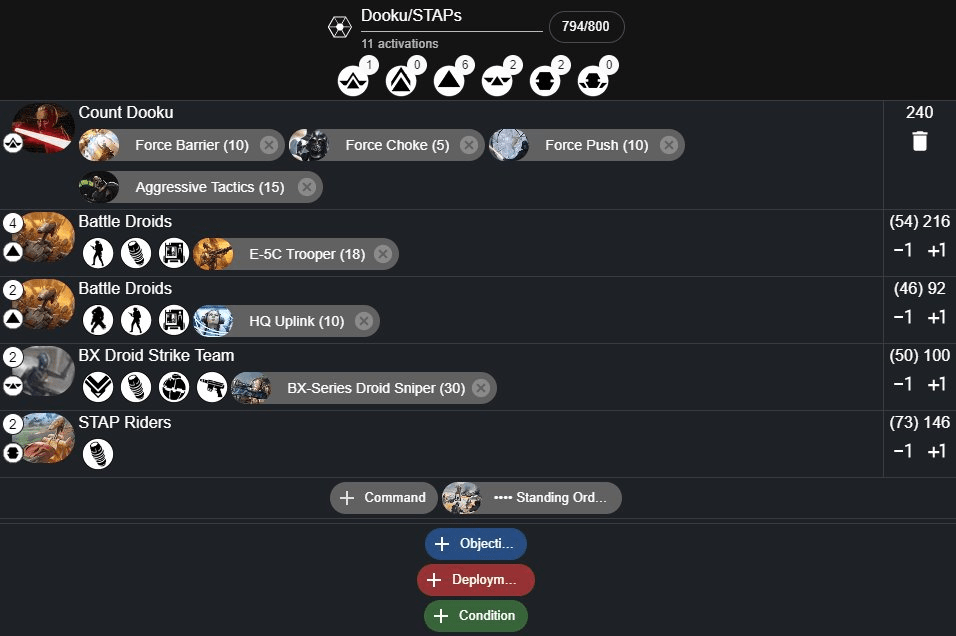
This list has a control focus unit (Dooku) a pair of scalpel focus units (STAPs) and a beefy bunch of B1s with two sniper strike teams to round out the core.
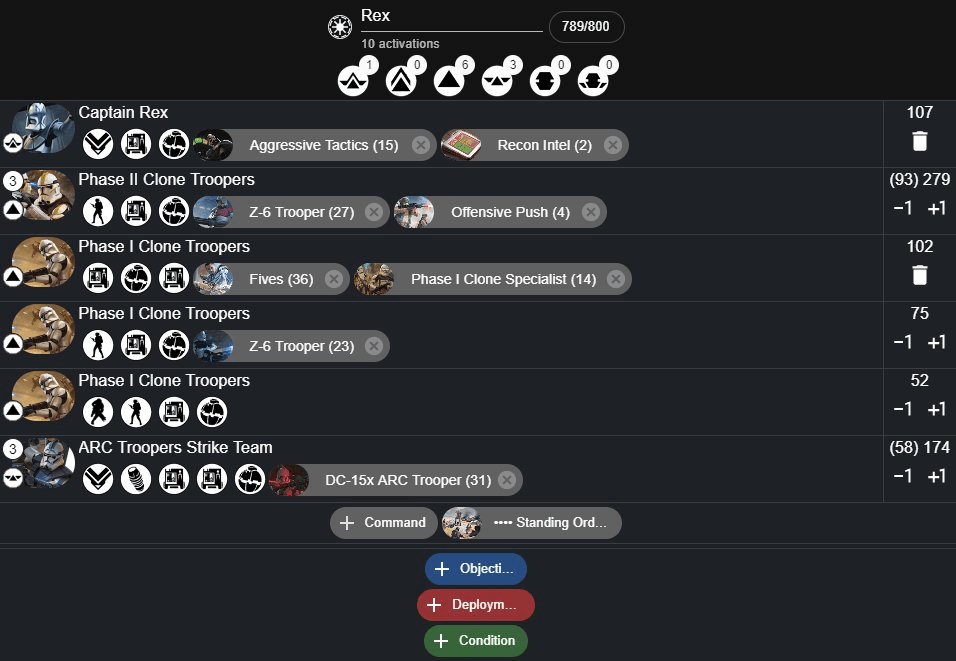
This list concept has gone up a lot in points with the update, but it’s still great. You have a beefy corps, some Phase IIs to take advantage of Take That Clankers, and some good old fashioned Fives fire support. It’s not complicated, but it hits like a truck.
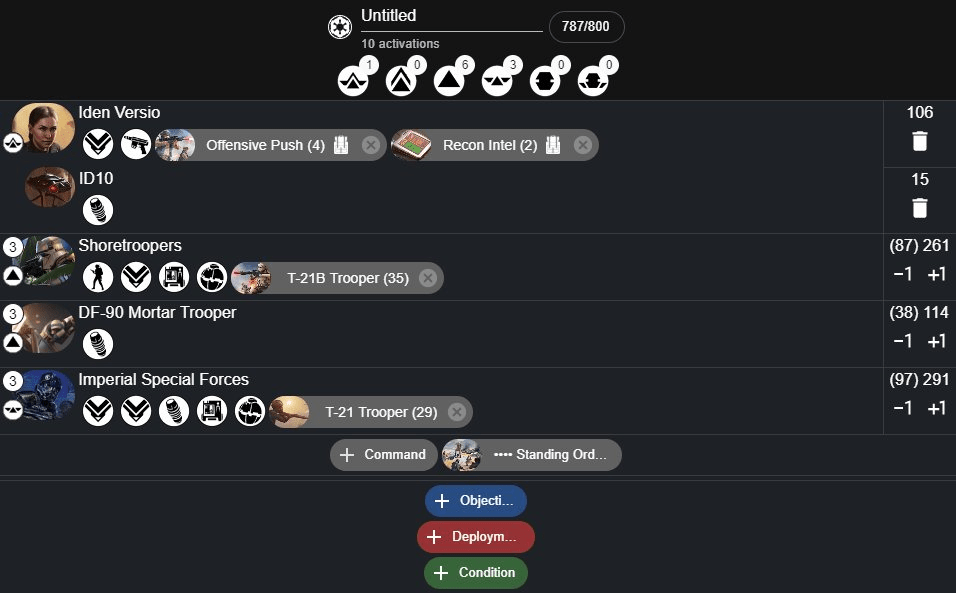
This is popular Empire list these days. You have your focus units (Iden and the ISF) and a core (Shores and Mortars). Super lean, still ten activations.
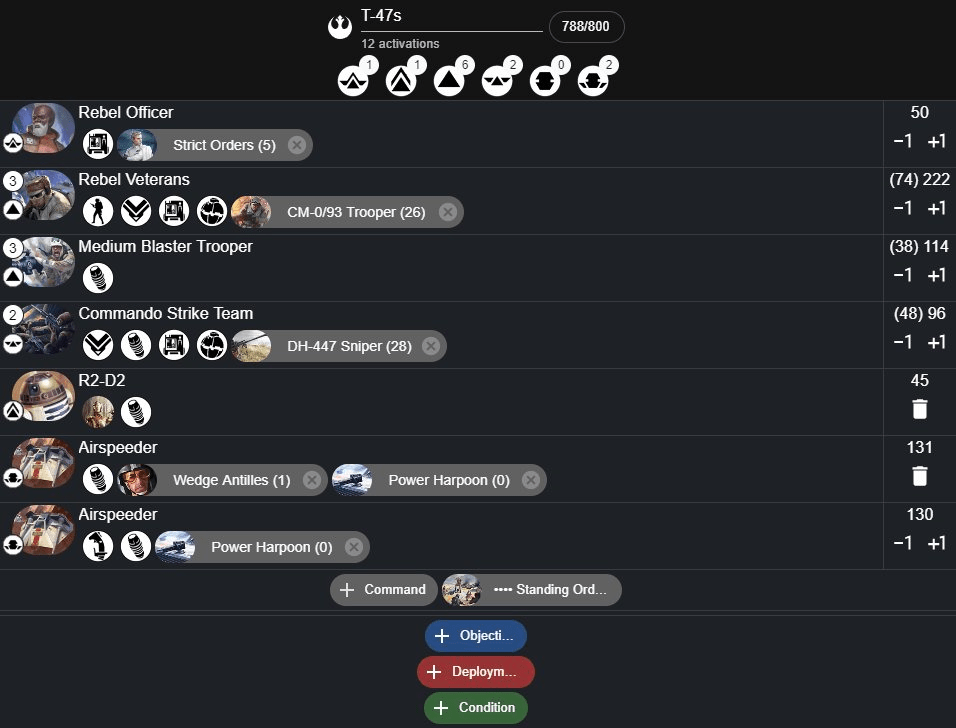
Two months ago, if I told you this was a competitive list, you would have thought I was crazy. Pretty much all of the units in this list got better, cheaper, or both in the update, except R2 and the snipers.
You have a pair of scalpel focus pieces (the T-47s), a support character (the officer), and a solid core of veterans and Mk2s. You also have Secret Mission and Repair in R2, which could could in handy with the T-47s.
List building is about creating a focus, supporting your focus, and staying lean. Every point matters, and every unit and upgrade has a role. Make sure you understand what that role is and how your choices effect how your list works together.
Most importantly, once you have a list, practice with it and test it. Know your list and each unit’s role.
May the force be with you, and happy list-building.
Copyright © 2024 The Fifth Trooper. All Rights Reserved.
8 Responses
Thank you for that very good articel.
You have a small mistake in your clone List. Fives and a Captain can‘t be in the Same list because of leader keyword.
Oh it is a specialist.
My mistake
I believe certain factions need 10-11 activations to win. I don’t believe all of them do. I am 7-0 against all the meta lists with my 7 activation list. Going up against the guys that normally win our tournaments. Faction I believe that need to be high on activation are Rebels normally 10 or Higher there effective health is based on activations. Imperials 9-10. CIS 8-10 and Republic 7-9. Great article though really makes people see things they may have been missing.
Yeah, like I said at the start of the article… you do you. These are just my observations and experience. If 7 activations is working for you, that’s fine.
I’m not sure if you play on TTS, but I would suggest signing up for Invader. You have people from all over the world play so it’s a great way to test a list outside your normal pool of opponents (besides convention tournaments, but obviously that’s not a thing at the moment).
what are you rocking at 7 acts? You are the first person that has even talked about 7 acts, let alone one that wins
https://legionhq.thefifthtrooper.com/list/republic/1gwnddtiknc,2kzlf00000,1kzlh00000,2fzkd0000,1gyhp000, However I been playtesting Anakin with force reflexes instead of force barrier running 3 P1 with portable scanners on all the P1 giving 2 P1 Clone Captain and Situational Awareness and then giving all the Arc’s Situational awareness. Both list have been doing really well as long as I go defensive and move carefully. They are not easy lists to play and you need to know what your up against.
Kyle , love all the NS casts by the way! So you used to be down on Rebel Vets/Mark IIs, but now not so much. How to you think their value has increased aside from the Cm’s in range. Also..can you think of any Invader League participants that are doing really well with multiple Vet/mark II lists? I bought and painted 2 boxes and I’ll be damned if I don’t get any use out of them. Thanks.
Ian S.
this is a great article for beginners too. really helps focus the attention! thanks